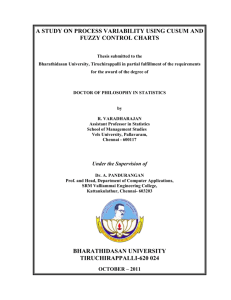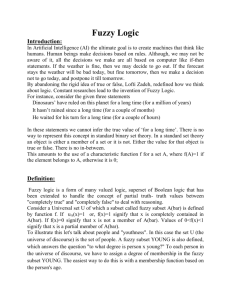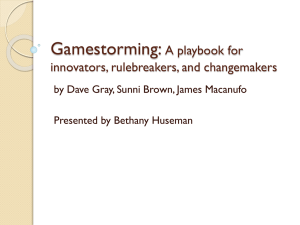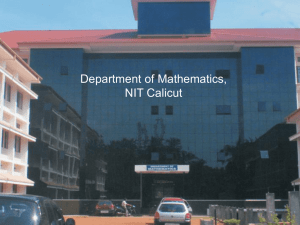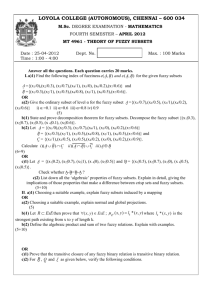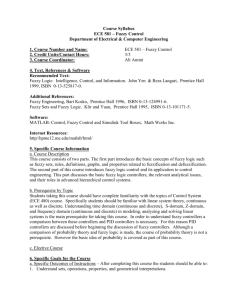Application of Probability and Fuzzy logic in a
advertisement
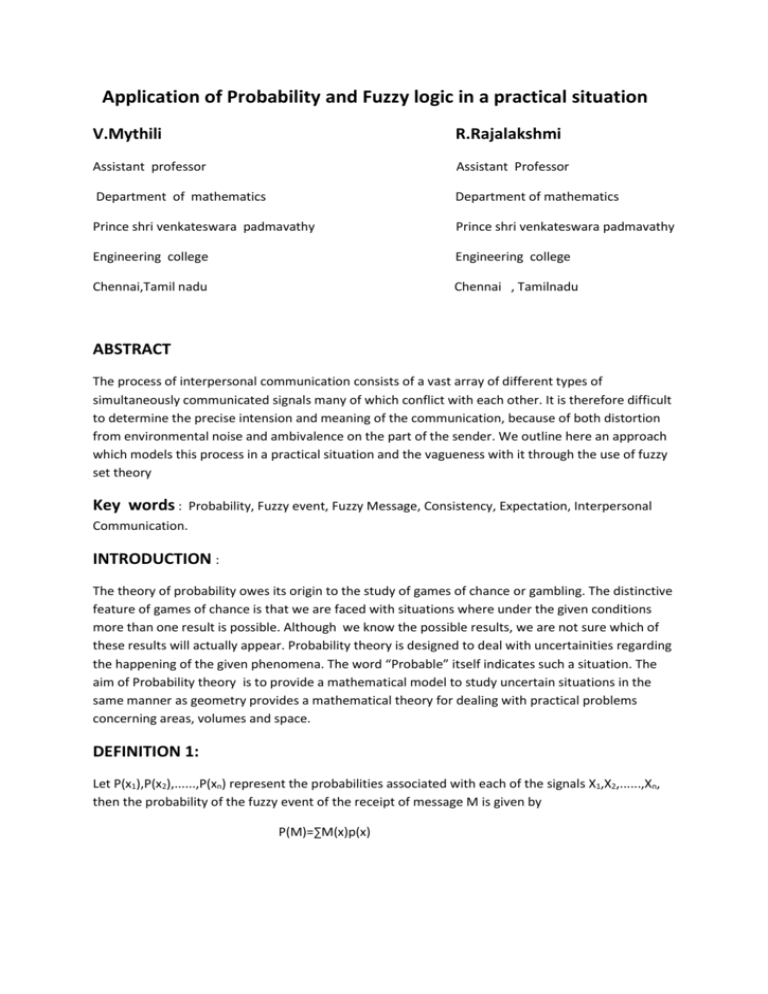
Application of Probability and Fuzzy logic in a practical situation
V.Mythili
R.Rajalakshmi
Assistant professor
Assistant Professor
Department of mathematics
Department of mathematics
Prince shri venkateswara padmavathy
Prince shri venkateswara padmavathy
Engineering college
Engineering college
Chennai,Tamil nadu
Chennai , Tamilnadu
ABSTRACT
The process of interpersonal communication consists of a vast array of different types of
simultaneously communicated signals many of which conflict with each other. It is therefore difficult
to determine the precise intension and meaning of the communication, because of both distortion
from environmental noise and ambivalence on the part of the sender. We outline here an approach
which models this process in a practical situation and the vagueness with it through the use of fuzzy
set theory
Key words :
Probability, Fuzzy event, Fuzzy Message, Consistency, Expectation, Interpersonal
Communication.
INTRODUCTION :
The theory of probability owes its origin to the study of games of chance or gambling. The distinctive
feature of games of chance is that we are faced with situations where under the given conditions
more than one result is possible. Although we know the possible results, we are not sure which of
these results will actually appear. Probability theory is designed to deal with uncertainities regarding
the happening of the given phenomena. The word “Probable” itself indicates such a situation. The
aim of Probability theory is to provide a mathematical model to study uncertain situations in the
same manner as geometry provides a mathematical theory for dealing with practical problems
concerning areas, volumes and space.
DEFINITION 1:
Let P(x1),P(x2),......,P(xn) represent the probabilities associated with each of the signals X1,X2,......,Xn,
then the probability of the fuzzy event of the receipt of message M is given by
P(M)=∑M(x)p(x)
DEFINITION 2:
The possibility distribution r(x)
ϵ [0,1] indicates the receiver’s belief in the possibility of signal x
being sent. The total possibility of the fuzzy message M is calculated as
r(M)=max[min(M(x),r(x))]
DEFINITION 3:
If the received message conflicts with the expected possibility of communication, then the receiver
may attempt clarification by requesting a repetition of the transmission. Before this new
transmission is sent, the receiver will probably have already modified his or her expectations based
on the previous message. If ro indicates the initial possibilistic expectations of the receiver and r1 is
the modified expectations subsequent to the receipt of message M, then
r1(x)=min[r0α(x),M(x)]
for each x
ϵ X, where α indicates the degree to which past messages are considered relevant is the
modifications of expectations.
An additional complication is introduced when we consider that the receiver may also introduce
distortions in the message because of inconsistency with the expectations. Let
S(M,r)=max[min(M(x),r(x))]–①
correspond to the consistency of the received message with the probabilistic expectations. Then let
M’ denote the message that the receiver actually hears, where M’(x)=Ms(x).
for each x
ϵ X where S=S(M,r)
The less consistent M is with the expectations, the less M’ resembles M. Since the receiver will be
modifying his or her expectations based on the message thought to have been received, the new
possibilisitic expectation structure is given by
r1(x)=min[r01-s(x),M’(x)] – ②
for each x
ϵ X.
Finally, once a determination has been made of the signal x
ϵ X that was sent, an appropriate
response must be chosen. Let Y be the universal set of all responses and let R Y x X be a fuzzy
binary relation in which R(y,x) indicates the degree of appropriateness of response of given signal x.
A fuzzy response set A
ϵ Y can be generated by composing the appropriateness relation R with the
fuzzy message M,
A=R ᵒ M (or) A(y)=max[min(R(y,x),M(x))] – ③
for each y
ϵ Y.
The following example illustrates the use of this model of interpersonal communication.
Suppose that a young man has just proposed marriage to a young woman and is now eagerly
awaiting her response. Let us assume that her answer will be chosen from the set X of the following
responses.
x1=simple yes
x2=simple no
x3=request for time to think it over
x4=request for the young man to ask permission of the young woman’s parents
x5=derisive laughter
x6=Joyful tears.
Assume also that the young man has expectations of her response represented by the possibility
distribution
ro=(.9,.1,.7,.3,.1,.6)
The above distribution shows that the young man expects a positive answer.
Now assume that he receives the following message
M1=.1/x1+.8/x2+.4/x3+.1/x5
The message is inconsistent with the young man’s expectations.
From eqn ①,
consistency
S(M1,ro)=max[min(M(x),r(x))]
=max[min(.1,.9),min(.8,.1),min(.4,.7),min(.1,.1)]
=max[.1,.1,.4,.1]
=.4
As the message is contrary to the young man’s expectations, he introduces some distortion in such a
way that the message he heard is
M1’=.4/x1+.9/x2+.7/x3+.4/x5
Based on this message, he modifies his expectations according to equation ②
r1(x)=min[ro1-0.4(x),M1’(x)]=min[ro0.6(x),M1’(x)]
for each x
ϵ X.
ie)r1=.4/x1+.25/x2+.7/x3+.25/x5
The young man has reduced his level of expectation of x1 ie)”A simple Yes”. Somewhat he increased
his expectation of x2 ie)”A simple no” and of x5 ie)”Derisive laughter” and has given up all hope of
possibilities of joyful tears.
Suppose now that in disbelief he asks the young woman to repeat her answer and receives the
following message
M2=.9/x2+.4/x5
This message is stronger,clearer and less general than the first answer. Its consistency with the
young man’s new expectation is
S(M2,r1)=max[min( M2(x),r(x)]
=max[min(0,.4),min(.9,.25),min(0,.7),min(.4,.25)]
=max[0,.25,0,.25]
=.25
Thus the message is highly contrary even to the revised expectation of the young man, so let us
suppose that he distorts the message such that he hears
M2’=.9/x2+.8/x5
His surprise has diminished the clarity of the message heard and has led him to exaggerate the
degree to which he believes that the young woman has responded with derisive laughter.
Let us suppose that the response which the young man makes will have the characteristics chosen
from the set
Y={y1,y2,...,y7}
where
y1=happiness
y2=pain
y3=surprise
y4=anger
y5=patience
y6=impatience
y7=affection
Let the fuzzy relation R Y x X represent the degree to which the young man plans to respond to a
given signal x with a response having the attribute to y.The following matrix represents the above
relation
x1
x2
x3
x4
x5
x6
y1
0.9
0
0.2
0
0
1
y2
0
0.9
0.1
0.2
1
0
y3
0.1
0.9
0.2
0.9
1
0.3
y4
0
0.5
0
0.6
0.7
0
y5
0.1
0
0.9
0
0
0.5
y6
0
0.3
0.2
0.3
0.4
0
y7
0.9
0
0.9
0.3
0
1
Using equation ③ we can calculate the response the young man will make to the message M2’
A(y1) = max[min(R(y1,x),M2’(x))]
= max[min(.9,0),min(0,.97),min(.2,0),min(0,0),min(0,.8),min(1,0)]
= max[0,0,0,0,0,0]
=0
A(y2) = max[mjn(R(y2,x),M2’(x))]
= max[min(0,0),min(.9,.97),min(.1,0),min(.2,0),min(1,.8),min(0,0)]
= max[0,.9,0,0,.8,0]
= .9
A(y3) = max[min(R(y3,x),M2’(x))]
= max[min(.1,0),min(.9,.97),min(.2,0),min(.9,0),min(1,.8),min(.3,0)]
= max[0,.9,0,0,.8,0]
= .9
A(y4) = max[min(R(y4,x),M2’(x))]
= max[min(0,0),min(.5,.97),min(0,0),min(.6,0),min(.7,.8),min(0,0)]
= max[0,.5,0,0,.7,0]
=.7
A(y5) = max[min(R(y5,x),M2’(x))]
= max[min(.1,0),min(0,.97),min(.9,0),min(0,0),min(0,.8),min(.5,0)]
= max[0,0,0,0,0,0]
=0
A(y6) = max[min(R(y6,x),M2’(x))]
= max[min(0,0),min(.3,.97),min(.2,0),min(.3,0),min(.4,.8),min(0,0)]
= max[0,.3,0,0,.4,0)
= .4
A(y7) = max[min(R(y7,x),M2’(x))]
= max[min(.9,0),min(0,.97),min(.9,0),min(.3,0),min(0,.8),min(1,0)]
= max[0,0,0,0,0,0]
=0
Therefore,
A = RᵒM2’=.9/y2 +.9/y3 +.7/y4 +.4/y6
CONCLUSION:
The young man’s response therefore will have the characteristics of a great deal of pain and
surprise , a large degree of anger and some impatience.
REFERENCES:
1) George J.Klir/Bo Yuan, Fuzzy Sets and Fuzzy Logic, Theory and Applications,PHI Learning
Private Limited, New Delhi.
2) Probability and Statistics with Reliability,Queuing and Computer Science
Applications,Kishore S.Trivdei,PHI Learning Private Limited,New Delhi
3) Probability,Statistics and Queuing Theory with Computer Science Applications,Arnold o.Allen
Academic Press,An imprint of Elsevier.
4) Probability,Statistics and Random Processes,T.Veerarajan,Tata McGraw Hill Education
Private Limited,New Delhi.
5) Understanding Neural Networks and Fuzzy Logics-Stamatios V.Kartalopoulos,IEEE Neural
Networks Council.
6) Neural Networks and Fuzzy Systems-Bart Kosko,University of Southern California,Prentice
Hall of India Private Limited, New Delhi.




